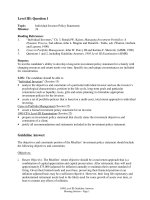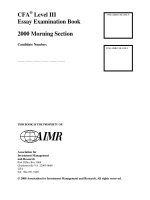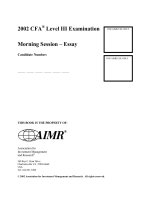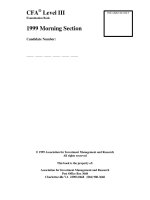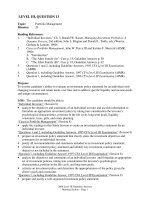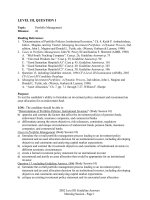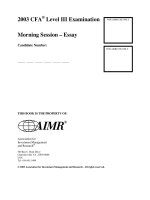L3 mock sample exam CFA level III essay questions 2012
Bạn đang xem bản rút gọn của tài liệu. Xem và tải ngay bản đầy đủ của tài liệu tại đây (154.27 KB, 36 trang )
Level III
Page 1
The Morning Session of the 2012 Level III CFA® Examination has 9 questions.
For grading purposes, the maximum point value for each question is equal to the
number of minutes allocated to that question.
Question
1
2
3
4
5
6
7
8
9
Topic
Minutes
Portfolio Management – Individual
Portfolio Management – Individual
Portfolio Management – Monitor/Rebalance/Execution
Portfolio Management – Individual/Behavioral
Portfolio Management – Economics
Portfolio Management – Institutional
Portfolio Management – Fixed Income
Portfolio Management – Derivatives
Portfolio Management – Derivatives
Total:
© 2012 CFA Institute. All rights reserved.
27
9
21
17
24
34
23
13
12
180
Page 2
Level III
THIS PAGE INTENTIONALLY LEFT BLANK
ANY MARKS MADE ON THIS PAGE WILL
NOT BE GRADED
© 2012 CFA Institute. All rights reserved.
Level III
Page 3
Questions 1 and 2 relate to Juan Pablo Alonso. A total of 36 minutes is allocated to these
questions. Candidates should answer these questions in the order presented.
QUESTION 1 HAS FIVE PARTS (A, B, C, D, E) FOR A TOTAL OF 27 MINUTES.
Juan Pablo Alonso, age 40, is the manager of a national, publicly-funded soccer team located in a
country that uses the U.S. dollar (USD) as its currency. This country’s debt is rated AAA.
Alonso has a one-year employment contract that has been renewed for several years. He is
confident that he can maintain this job, or a similar managing position, until his planned
retirement at age 55. Alonso is divorced and the father of teenage children. He wants to fund a
dedicated trust to provide for his children’s needs until they reach age 25. He will need USD
250,000 within the next few months to fund the trust.
Alonso’s income tax rate is 30%. Other than a small cash reserve, he holds all of his investment
assets in a tax-exempt account with a current value of USD 900,000. Contributions to this
account are made after tax. Withdrawals are entirely tax-free, without penalty. Alonso saves
USD 25,000 of his after-tax income every year, and plans to continue doing so until retirement.
His next contribution will be made in one year. As part of his normal expenses, Alonso annually
provides approximately USD 30,000 of support to local youth sporting leagues.
When Alonso retires in 15 years, he plans to purchase a 25-year annuity that pays USD 100,000
after tax annually. He will need USD 1,600,000 at retirement to fund the annuity. Alonso expects
the annual payout to be sufficient to meet all his needs on an inflation-adjusted basis. He does
not plan to leave any estate at his death.
A.
Calculate the required annual return that would enable Alonso to purchase the retirement
annuity at age 55. Show your calculations.
Note: Assume all cash flows occur at the end of each period.
(5 minutes)
B.
Discuss two reasons why Alonso’s ability to take risk could be considered above average.
(4 minutes)
Five years have passed, and Alonso, age 45, signs a 10-year employment contract, which
includes a one-time signing bonus, with a corporate-owned professional soccer club. His annual
base salary with this club is higher than his previous salary and is indexed to inflation. Because
the club has had financial difficulties in the past, the owner agrees to guarantee Alonso’s salary
over the life of the contract. Alonso intends to keep his living expenses unchanged and increase
his annual savings.
Alonso still plans to retire at the end of the 10-year contract. Given his improved financial
position, he now plans to depend on cash flow from his investment portfolio to meet retirement
expenses rather than purchase the 25-year annuity.
© 2012 CFA Institute. All rights reserved.
Page 4
C.
Level III
i.
Describe one change in Alonso’s circumstances that has decreased his earnings
risk and one change that has increased his earnings risk.
ii.
Describe one change in Alonso’s circumstances that has decreased his financial
market risk in retirement and one change that has increased his financial market
risk in retirement.
ANSWER QUESTION 1-C IN THE TEMPLATE PROVIDED ON PAGE 7.
(8 minutes)
D.
Discuss how each of the following investment constraints has changed for Alonso:
i.
ii.
time horizon
liquidity needs
(4 minutes)
Alonso has a buy-and-hold portfolio of individual securities, including treasury bills, assetbacked securities (ABS), government bonds, and equities. His current portfolio allocation is
shown in Exhibit 1.
Exhibit 1
Alonso’s Current Portfolio Allocation
Portfolio
Asset Class
Weight
Treasury bills
5%
A-rated corporate amortizing ABS
10%
AAA-rated government bonds
10%
Small-cap domestic equities
25%
Large-cap international equities
50%
E.
Determine which one asset class in Alonso’s portfolio most closely resembles his current
human capital. Justify your response with two reasons.
ANSWER QUESTION 1-E IN THE TEMPLATE PROVIDED ON PAGE 9.
(6 minutes)
ANY MARKS MADE ON THIS PAGE WILL
NOT BE GRADED
© 2012 CFA Institute. All rights reserved.
Level III
Page 7
Answer Question 1 on This Page
Template for Question 1-C
i. Describe one change in Alonso’s circumstances that has:
decreased his
earnings risk.
increased his
earnings risk.
ii. Describe one change in Alonso’s circumstances that has:
decreased his
financial market
risk in retirement.
increased his
financial market
risk in retirement.
© 2012 CFA Institute. All rights reserved.
Level III
Page 9
Answer Question 1 on This Page
Template for Question 1-E
Determine which one asset
class in Alonso’s portfolio most
closely resembles his current
human capital.
(circle one)
Justify your response with two reasons.
1.
Treasury bills
A-rated corporate
amortizing ABS
AAA-rated
government bonds
2.
Small-cap
domestic equities
Large-cap
international equities
© 2012 CFA Institute. All rights reserved.
Page 14
Level III
Questions 1 and 2 relate to Juan Pablo Alonso. A total of 36 minutes is allocated to these
questions. Candidates should answer these questions in the order presented.
QUESTION 2 HAS TWO PARTS (A, B) FOR A TOTAL OF 9 MINUTES.
Juan Pablo Alonso is now age 54 and anticipating retirement. Approximately 60% of his total
investments are currently held in a tax-exempt account and 40% in a taxable account.
Contributions into both accounts are made with after-tax income. In the tax-exempt account,
withdrawals are entirely tax-free and without penalty. In the taxable account, Alonso now incurs
a 20% tax on both income and realized capital gains. Realized losses can be used to offset
current or future income and capital gains.
Alonso experienced substantial losses in both of his investment accounts over the past year. He
estimates that he will need to postpone retirement and questions whether his investments were
structured optimally. Alonso meets with his advisor to discuss the effects of the tax regime on his
portfolios. The advisor suggests that over the last year, both Alonso’s after-tax return and
investment risk would have been higher if a larger proportion of assets had been held in the
taxable account.
A.
Determine, based only on tax considerations, whether Alonso’s advisor is correct or
incorrect with respect to Alonso’s:
i.
ii.
after-tax return.
investment risk.
Justify each response with one reason.
ANSWER QUESTION 2-A IN THE TEMPLATE PROVIDED ON PAGE 15.
(6 minutes)
Alonso’s advisor proposes a 100,000 U.S. dollar (USD) investment in a portfolio of dividendpaying equities in the taxable account. All dividend income and realized capital gains would be
taxed at 20% and reinvested. The advisor suggests a strategy of realizing no more than half of the
available capital gains annually. He estimates the 3-year and 15-year accrual equivalent returns
on the proposed portfolio to be 5.8% and 6.3%, respectively.
B.
Explain why the estimated accrual equivalent returns differ for the two time periods.
Note: No calculations are required.
(3 minutes)
ANY MARKS MADE ON THIS PAGE WILL
NOT BE GRADED
© 2012 CFA Institute. All rights reserved.
Level III
Page 15
Answer Question 2 on This Page
Template for Question 2-A
Determine, based only on tax
considerations, whether
Alonso’s advisor is correct or
incorrect (circle one) with
respect to Alonso’s:
Justify each response with one reason.
correct
i. after-tax
return
incorrect
correct
ii. investment
risk
incorrect
© 2012 CFA Institute. All rights reserved.
Page 20
Level III
THIS PAGE INTENTIONALLY LEFT BLANK
ANY MARKS MADE ON THIS PAGE WILL
NOT BE GRADED
© 2012 CFA Institute. All rights reserved.
Level III
Page 21
QUESTION 3 HAS THREE PARTS (A, B, C) FOR A TOTAL OF 21 MINUTES.
Wendy Kadar, CFA, manages an equity fund that invests globally. Among the countries she
invests in are Alphastan and Betania. Both countries use the euro (EUR) as their currency.
Information about each equity market is shown in Exhibit 1.
Exhibit 1
Alphastan and Betania Equity Markets
Alphastan
Betania
Market type
Quote-driven
Quote-driven
Average daily volume
25 million shares
15 million shares
Market volatility
22%
16%
Latest 12-month market return 5.3%
15.1%
Number of member firms
5
32
Market hours
Tuesday - Thursday: Monday - Friday:
9:00am - 4:00pm
9:00am - 4:00pm
Founding year
1973
1903
The order books for typical Alphastan and Betania equities with identical market capitalizations
and free floats appear in Exhibits 2 and 3.
Exhibit 2
Limit Order Book for a Typical Alphastan Equity
Bid
Ask
Dealer
Dealer
Price
Price
Size
Size
(EUR)
(EUR)
A
49.82
200
C
50.11
200
B
49.73
400
D
50.26
1000
C
48.22
600
A
51.31
500
D
47.68
500
B
51.55
600
Exhibit 3
Limit Order Book for a Typical Betania Equity
Bid
Ask
Dealer
Dealer
Price
Price
Size
Size
(EUR)
(EUR)
A
49.88
800
C
50.13
900
B
49.81
1000
D
50.19
1000
C
49.75
1900
A
50.31
1500
D
49.50
1700
B
50.38
2600
© 2012 CFA Institute. All rights reserved.
Page 22
Level III
From the information provided in Exhibits 1, 2, and 3, Kadar concludes that Betania has a higher
quality market.
A.
Identify three market characteristics that support Kadar’s conclusion that Betania has a
higher quality market. Justify each response with one reason.
ANSWER QUESTION 3-A IN THE TEMPLATE PROVIDED ON PAGE 23.
(9 minutes)
Kadar expects to receive a large inflow of cash into her fund from a new client. When investing
the new money, she intends to use algorithmic execution for the trades. Global equity markets
have been volatile and trending upwards and Kadar forecasts this will continue.
B.
Determine which algorithmic participation strategy [volume-weighted average price
(VWAP), time-weighted average price (TWAP), or implementation shortfall] is most
appropriate for Kadar’s trades. Justify your response with two reasons.
ANSWER QUESTION 3-B IN THE TEMPLATE PROVIDED ON PAGE 24.
(6 minutes)
Kadar’s firm offers clients the ability to reduce their risk exposure by investing in a mix of riskfree securities and Kadar’s global equity fund. Clients are able to select a rebalancing strategy
that best suits their preferences. The available rebalancing strategies are buy-and-hold, constantmix, and constant-proportion portfolio insurance (CPPI).
A new client, Guy Marsden, agrees with Kadar’s forecast for the global equity markets. He
invests EUR 250,000 from his tax-exempt account in a mix of risk-free securities and Kadar’s
global equity fund. He does not want the value of his portfolio to fall below EUR 175,000, but is
willing to accept additional risk as his portfolio value increases.
C.
Determine which of the available rebalancing strategies (buy-and-hold, constant-mix, or
CPPI) is most appropriate for Marsden. Justify your response with two reasons.
ANSWER QUESTION 3-C IN THE TEMPLATE PROVIDED ON PAGE 25.
(6 minutes)
ANY MARKS MADE ON THIS PAGE WILL
NOT BE GRADED
© 2012 CFA Institute. All rights reserved.
Level III
Page 23
Answer Question 3 on This Page
Template for Question 3-A
Identify three market
characteristics that support
Kadar’s conclusion that Betania
has a higher quality market.
Justify each response with one reason.
Characteristic 1:
Characteristic 2:
Characteristic 3:
© 2012 CFA Institute. All rights reserved.
Page 24
Level III
Answer Question 3 on This Page
Template for Question 3-B
Determine which algorithmic
participation strategy
[volume-weighted average
price (VWAP), timeweighted average price
(TWAP), or implementation
shortfall] is most appropriate
for Kadar’s trades.
(circle one)
Justify your response with two reasons.
1.
volume-weighted
average price (VWAP)
time-weighted
average price (TWAP)
2.
implementation
shortfall
© 2012 CFA Institute. All rights reserved.
Level III
Page 25
Answer Question 3 on This Page
Template for Question 3-C
Determine which of the
available rebalancing
strategies (buy-and-hold,
constant-mix, or CPPI) is
most appropriate for
Marsden.
(circle one)
Justify your response with two reasons.
1.
buy-and-hold
constant-mix
2.
CPPI
© 2012 CFA Institute. All rights reserved.
Page 30
Level III
THIS PAGE INTENTIONALLY LEFT BLANK
ANY MARKS MADE ON THIS PAGE WILL
NOT BE GRADED
© 2012 CFA Institute. All rights reserved.
Level III
Page 31
QUESTION 4 HAS THREE PARTS (A, B, C) FOR A TOTAL OF 17 MINUTES.
An advisor for Alesi Capital Management is working with a new client, Melanie Stoffer. Prior to
meeting with her, the advisor asks Stoffer a series of diagnostic questions to determine whether
she may have any of the following investment behavioral biases:
•
•
•
•
•
anchoring
hindsight
regret aversion
representativeness
status quo
Sample diagnostic questions are shown in Exhibit 1.
1.
A.
Exhibit 1
Alesi Capital Management
Sample Diagnostic Questions
Would a prior investment decision that resulted in a loss stop you from
making a similar decision, even if the new investment appears to be the
best alternative?
2.
How frequently do you review your investment portfolio?
3.
Would you sell a recent equity investment following a management
announcement of a significant decline in the expected growth rate of
revenue?
Identify the behavioral bias that each diagnostic question in Exhibit 1 is most likely to
reveal.
Note: Each diagnostic question is designed to reveal a different bias.
ANSWER QUESTION 4-A IN THE TEMPLATE PROVIDED ON PAGE 33.
(6 minutes)
At their initial meeting, the advisor learns that Stoffer is a mid-level manager at a bank and has
built an investment portfolio by accumulating savings, stock options, and restricted stock from
her company. Stoffer believes she currently has a sufficient level of wealth to achieve her
primary goal of maintaining her current lifestyle until her death.
In discussing her investment philosophy, Stoffer explains that she likes to keep separate
investment accounts for her savings, stock options, and restricted stock. She has a distinct
investment strategy for each account. In addition, Stoffer says that she always follows her
father’s investment advice of “invest only in what you know.” Stoffer also believes that she is
© 2012 CFA Institute. All rights reserved.
Page 32
Level III
personally contributing to the performance of her bank’s stock price. Combined, these factors
have led Stoffer to keep a large percentage of her total portfolio in her bank’s stock and options.
The advisor tells Stoffer that this concentrated holding represents significant risk in achieving
her primary goal. Stoffer refuses to consider the suggestion that she partially hedge the risk of
her bank’s stock.
After evaluating Stoffer’s investment philosophy, the advisor is concerned that Stoffer is
exhibiting some of the following cognitive biases:
•
•
•
•
B.
endowment
conservatism
mental accounting
illusion of control
Identify two cognitive biases exhibited by Stoffer. Justify each response with one
reason.
ANSWER QUESTION 4-B IN THE TEMPLATE PROVIDED ON PAGE 34.
(6 minutes)
C.
Recommend whether the advisor should primarily attempt to moderate Stoffer’s biases,
or adapt his recommendations to better reflect Stoffer’s biases. Justify your response
with two reasons.
(5 minutes)
ANY MARKS MADE ON THIS PAGE WILL
NOT BE GRADED
© 2012 CFA Institute. All rights reserved.
Level III
Page 33
Answer Question 4 on This Page
Template for Question 4-A
Note: Each diagnostic question is designed to reveal a different bias.
Identify the behavioral bias that each
diagnostic question in Exhibit 1 is most
Diagnostic Question
likely to reveal.
(circle one)
anchoring
1. Would a prior investment decision that resulted
in a loss stop you from making a similar
decision, even if the new investment appears to
be the best alternative?
hindsight
regret aversion
representativeness
status quo
anchoring
hindsight
2. How frequently do you review your investment
portfolio?
regret aversion
representativeness
status quo
anchoring
3. Would you sell a recent equity investment
following a management announcement of a
significant decline in the expected growth rate
of revenue?
hindsight
regret aversion
representativeness
status quo
© 2012 CFA Institute. All rights reserved.
Page 34
Level III
Answer Question 4 on This Page
Template for Question 4-B
Identify two cognitive biases
exhibited by Stoffer.
(circle one)
Justify each response with one reason.
First cognitive bias:
endowment
conservatism
mental accounting
illusion of control
Second cognitive bias:
endowment
conservatism
mental accounting
illusion of control
© 2012 CFA Institute. All rights reserved.
Page 40
Level III
QUESTION 5 HAS FOUR PARTS (A, B, C, D) FOR A TOTAL OF 24 MINUTES.
Emergistan is a developing country founded 50 years ago that has exhibited significant economic
growth. In its first 38 years, Emergistan had low inflation. At that time, the country established a
central bank with a primary mandate to encourage economic growth. The resulting monetary
policy has led to 12 years of high and volatile inflation. Its equity market is well-established and
liquid. By contrast, secondary market transactions for bonds are small and infrequent.
Joe Cooke is an economist for a pension advisory firm. He is analyzing Emergistan to identify
investment opportunities. Cooke performs several analyses of Emergistan’s economy. Exhibit 1
contains a description of five of his analyses and selected comments from his report.
Analysis
Exhibit 1
Economic Analyses of Emergistan
Description of Each Analysis and Selected Comments
1
Cooke creates an econometric model to forecast inflation, using the full 50-year
history of Emergistan. He states: “Based on my model, I expect future inflation to
be much lower than the level we have seen in recent years.”
2
Cooke analyzes purchasing manager surveys to estimate the level of industrial
production in future quarters. He states: “Survey information of current conditions
and new orders both suggest rising industrial production in the next two quarters.”
3
Cooke performs a regression analysis on today’s developed economies when they
were at a similar stage of development as Emergistan is now. He states: “Based on
this analysis, Emergistan is likely to achieve average real GDP growth of 5% for
the next 10 years.”
4
Cooke constructs a daily series of bond prices for Emergistan’s bond market. He
interpolates prices between actual transaction data points. He states: “Based on
this analysis, Emergistan’s bond market has historically provided excellent returns
for the level of volatility experienced.”
5
Cooke examines Emergistan’s balance of payments and notes a small current
account deficit balanced by capital inflows. He states: “I expect this to continue
and the composition of the balance of payments to remain unchanged.”
© 2012 CFA Institute. All rights reserved.
Level III
A.
Page 41
Determine which of Cooke’s analyses in Exhibit 1 is most likely to be affected by each
of the following sources of error:
i.
ii.
iii.
survivorship bias
regime changes
appraisal data
Justify each response with one reason.
Note: Consider each source of error independently.
ANSWER QUESTION 5-A IN THE TEMPLATE PROVIDED ON PAGE 43.
(9 minutes)
Cooke prepares an analysis of Emergistan’s currency, the Emergistan Dinar (EMD), relative to
the U.S. dollar (USD). He collects the current economic data and five-year consensus forecasts
in Exhibit 2.
Exhibit 2
Current and Five-Year Forecasted Economic Data for Emergistan
Consensus
Current
Economic Factor
Forecast
(2012)
(2017)
Interest rate differential versus the U.S.
+4.7%
+6.4%
Inflation rate differential versus the U.S.
+4.1%
+5.8%
Unemployment rate
8.6%
8.4%
Foreign direct investment
1.9% of GDP
1.7% of GDP
GDP per capita (in EMD)
15,157
15,325
GDP growth (annualized)
4.3%
4.6%
B.
Determine whether the EMD is most likely to become stronger, weaker, or remain
unchanged relative to the USD, based on each of the following methodologies:
i.
ii.
purchasing power parity
capital flows
Justify each response with one reason.
Note: Consider each methodology independently and use only the economic data in
Exhibit 2.
ANSWER QUESTION 5-B IN THE TEMPLATE PROVIDED ON PAGE 44.
(6 minutes)
© 2012 CFA Institute. All rights reserved.
Page 42
Level III
Cooke analyzes the Emergistan equity market. He notes that Emergistan companies are currently
experiencing annual growth of 12% in earnings and dividends. He expects the growth rate to
decline linearly to 4% per year over a period of fifteen years, and then continue at 4% per year.
He gathers additional equity market information shown in Exhibit 3.
Exhibit 3
Emergistan Equity Market Information
Market Characteristic
Value
1144
Equity index level
EMD 81
Forecast index earnings per share (next 12 months)
EMD 46
Current index dividend per share (current year)
6.7%
Risk-free rate
10.2%
Equity discount rate
109
Assets at liquidation value (EMD billions)
152
Assets at replacement cost (EMD billions)
119
Equities at book value (EMD billions)
224
Equities at market value (EMD billions)
103
Debt at book value (EMD billions)
116
Debt at market value (EMD billions)
C.
Calculate the fair value of the Emergistan equity market using the H-model and the
information in Exhibit 3. Show your calculations.
(4 minutes)
D.
i.
Calculate Tobin’s q using the information in Exhibit 3. Show your calculations.
ii.
Judge whether Tobin’s q will most likely be higher, lower, or the same in the long
term. Justify your response with one reason.
Note: No calculations are required.
(5 minutes)
ANY MARKS MADE ON THIS PAGE WILL
NOT BE GRADED
© 2012 CFA Institute. All rights reserved.
Level III
Page 43
Answer Question 5 on This Page
Template for Question 5-A
Note: Consider each source of error independently.
Determine which of
Cooke’s analyses in
Exhibit 1 is most
likely to be affected
Source of error
Justify each response with one reason.
by each of the
following sources of
error.
(circle one)
1
2
i. survivorship bias
3
4
5
1
2
ii. regime changes
3
4
5
1
2
iii. appraisal data
3
4
5
© 2012 CFA Institute. All rights reserved.
Page 44
Level III
Answer Question 5 on This Page
Template for Question 5-B
Note: Consider each methodology independently and use only the economic data in
Exhibit 2.
Determine whether
the EMD is most likely
to become stronger,
weaker, or remain
Justify each response with one reason.
Methodology unchanged relative to
the USD, based on
each of the following
methodologies.
(circle one)
stronger
i. purchasing
power parity
weaker
remain unchanged
stronger
ii. capital
flows
weaker
remain unchanged
© 2012 CFA Institute. All rights reserved.
Page 50
Level III
QUESTION 6 HAS SIX PARTS (A, B, C, D, E, F) FOR A TOTAL OF 34 MINUTES.
Aquiline Chemical Corporation supplies chemicals for a wide range of industry applications. The
company has a mature product line and declining profitability. The company’s pension plan
administrator, Michael Trout, is revising the investment policy statement for Aquiline’s defined
benefit pension plan (the Plan). The following information applies to the Plan:
•
•
•
•
•
Discount rate applied to determine the present value of the Plan’s liabilities: 5.0%
Expected average annual inflation rate: 1.25%
Active lives as a percent of participants: 65%
Average age of workforce: 54 years
Plan status: fully funded
Aquiline has not had to make any contributions to the Plan in recent years. Although currently
fully funded, the Plan was in surplus until this year when an economic slowdown resulted in a
decline in the value of the Plan’s assets. Given Aquiline’s declining profitability, Trout believes
that the need to make future contributions would have a significant negative effect on the
company’s stock price. Pension asset returns are positively correlated with Aquiline’s operating
earnings.
The company has a mandatory retirement age of 65 and until recently, retirees received inflationadjusted pension payments. Effective 1 January of this year, Aquiline amended the Plan to
eliminate inflation adjustments for any future retirees. The amendment does not affect current
retirees or former employees with deferred benefits.
Starting next month, Aquiline will offer employees an early-retirement option. To be eligible,
employees must have 30 years of employment with the company and have reached the age of 60.
Trout is confident that many employees will choose early retirement. While this would increase
pension payments over the medium term, Aquiline believes that the labor force reduction will
allow the company to improve profitability.
A.
State the return objective of the Plan. Calculate the return requirement. Show your
calculations.
(4 minutes)
B.
Discuss two factors that contribute to the Plan’s low risk tolerance.
(4 minutes)
Trout is using an asset-only approach with an asset allocation of 70% equities and 30% fixed
income. He believes there is little risk to the fully-funded status of the Plan with this allocation.
Aquiline hires a pension consultant, Morris Rayburn, to evaluate the Plan’s asset allocation.
Rayburn disagrees with Trout’s view of the risk characteristics of the current asset-only
approach. Rayburn recommends that Aquiline use a liability-relative approach in allocating the
Plan’s assets.
© 2012 CFA Institute. All rights reserved.
